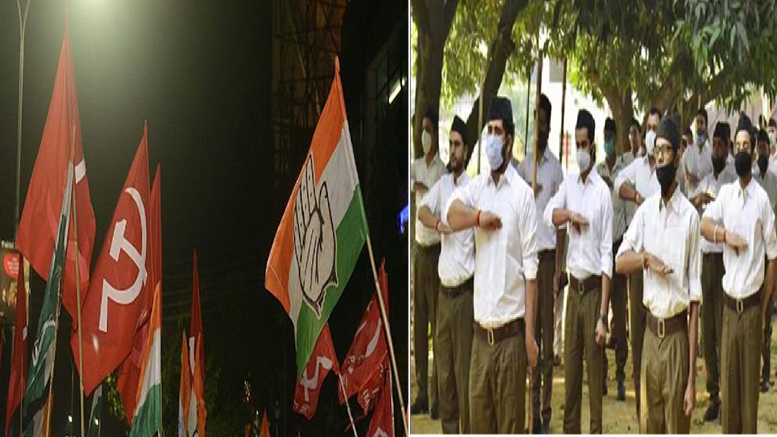Ashwani Kumar Chrungoo
The year 2025 marks a significant milestone for India’s three foremost all-India socio-political movements—Congress, the Communist Party, and the RSS. While Congress is celebrating its 140th anniversary this year, the other two organizations are also commemorating a century of their existence. This moment provides a compelling opportunity to examine their historical status in a chronological context.
The origins of Congress can be traced back to the Britishers’ influence, initiated by British ICS officer A.O. Hume on December 28, 1885. Initially, it served a limited purpose: to create a platform for Indians to address their grievances to the British government without any notion of independence. The British viewed it as a safe outlet for Indians to express their socio-political concerns. Eventually, A.O. Hume advocated for the idea of limited self-governance by Indians.
The Congress’s first President was W.C. Bonnerjee, a barrister from Bengal, who presided over the inaugural session of the Indian National Congress in Bombay (now Mumbai). He was re-elected as President in 1992 at Allahabad (now Prayagraj). Bonnerjee was allied with notable figures such as Dadabhai Naroji and Badruddin Tyabji, who formed the Indian Parliamentary Committee in England in 1893 before ultimately settling in England.
Over time, Congress evolved into a broader political platform addressing socio-economic and political issues pertinent to India. The partition of Bengal along communal lines by the British in 1905 sparked widespread outrage among Indians, which Congress effectively channeled into organized resistance. Leadership transitioned to Gopal Krishen Gokhale, Lala Lajpat Rai, Bal Gangadhar Tilak, and Bipin Chandra Pal, who intensified the political ambitions and transformed Congress into a fully-fledged political party.
Mahatma Gandhi and Jawahar Lal Nehru assumed leadership just before the pivotal Nagpur session of the AICC in 1920, after which Congress redefined itself as a movement for freedom from British rule. By 1930, during the AICC session on the banks of the river Ravi near Lahore, Congress proclaimed its goal of achieving ‘complete independence’ from British control.
In 1942, during its session in Mumbai, Congress called for the ‘Quit India’ movement against the British government. However, it capitulated to demands from the Muslim League led by M.A. Jinnah, resulting in the partition of India based on communal lines. The Indian nation gained independence from British rule in 1947, but at a significant cost, leading to the creation of two new Dominions: India and Pakistan.
Utilizing the momentum of the freedom movement, Congress maintained power in India for six decades post-independence, until it was first ousted from the central government in 1977. Although it intermittently regained power, it has faced diminishing influence, particularly against the BJP. Currently, Congress finds itself in opposition for the third consecutive term at the central level and has lost power in most states, retaining influence only in two coalition governments.
From an earlier dominant voter base of 40 to 50 percent nationally, Congress’s support has now dwindled to around 20 percent, coupled with a significant leadership crisis. It has devolved into a feudal dynastic party, struggling for relevance as a premier political entity after 140 years of its establishment.
The Communist Party of India was established on December 26, 1925, in Kanpur (UP). There exists a contention on its founding year, as CPI(M), which emerged from the split in CPI in 1964, considers 1920 as the origin of the communist movement in India. Notable founders include M.N. Roy, Ambani Mukerjee, and Evelyn, Roy’s wife.
The extension of communist ideology in India was heavily influenced by Karl Marx and the 1917 Bolshevik revolution in Russia. They engaged in resistance against British colonization and advocated for land reforms and caste equity, stimulating trade union movements and raising the issues of peasants and laborers on a national stage. In 1934, British authorities banned the Communist Party but it aligned itself with a significant segment of India’s educated youth. CPI was a primary opposition force in India during the 1950s and 1960s but divided in 1964 due to the fallout from the 1962 Sino-Indian conflict.
Communist leaders adopted an extreme left-liberal stance, distancing themselves from India’s cultural and civilizational influences. The Naxalite movement is intricately linked to this radical ideology, alongside smaller communist factions part of the left alliance. Beyond union activities, communists garnered influence through media, education, and intellectual spheres during Congress’s rule; however, their primary voter base has remained concentrated in states like Kerala, West Bengal, Tripura, Bihar, Tamil Nadu, and Punjab.
In the context of the global decline of communism over the past few decades, the communist movement in India has significantly contracted, with its national-level support diminishing. The centenary-old movement has effectively transformed into a regional faction with limited parliamentary representation, losing its former prestige, leadership, and union dominance. It now finds itself in a struggle for survival at both national and regional levels.
Dr. K.B. Hedgewar, a physician, founded the Rashtriya Swayamsevak Sangh (RSS) on September 27, 1925, coinciding with Vijayadashami, in Nagpur, Maharashtra. Born in the same city in 1889, Hedgewar, a dedicated patriot from a young age, was involved in various anti-British activities during his schooling and was part of the revolutionary Anusheelan Samiti. He contributed to organizing the AICC session in Nagpur as a Congress youth leader and, despite later disagreements regarding Congress’s alignment with the Khilafat movement, he was imprisoned in 1930 for supporting Congress’s call for independence.
Hedgewar believed that the British and past Muslim invaders governed India due to the disunity among its indigenous Hindus. He organized Hindu youth into daily “shakhas,” instilling patriotic values rooted in Hindutva ideology. This network flourished into a vast organization throughout India, profoundly impacting socio-political and cultural dimensions within fifty years, under the guidance of the influential second RSS chief, Guruji Golwalkar.
The Congress government imposed three bans on the RSS: in 1948 after Gandhi’s assassination, in 1975 during the emergency, and in 1992 during the Babri demolition. Each time, courts absolved the RSS of the allegations. The RSS ideology was significantly shaped by Hindutva ideologue and freedom fighter Veer Savarkar. Through unwavering commitment and sacrifice from its volunteers, it emerged as the world’s largest socio-cultural organization in less than a century, with branches across over 50 countries. The RSS has left a remarkable mark across various fields—politics, trade unionism, education, culture, and economic upliftment—with individuals like Atal Bihari Vajpayee and Narendra Modi among its ranks.
As all three significant socio-political movements in India celebrate their historical milestones this year, the RSS stands out with clarity of vision, resilience, and hope for the nation. In its centennial year, it embraces a monumental responsibility to guide the nation towards peace, prosperity, and national pride while focusing equally on cultural and civilizational democracy, distinguishing it as a unique organization.
(The author is a senior BJP & KP leader)


Leave a Reply